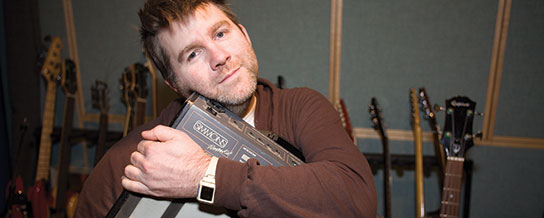LCD Soundsystem In The Studio
Some might say that James Murphy leads two lives: frontman of the disco-friendly LCD Soundsystem, […]

LCD Soundsystem In The Studio
Some might say that James Murphy leads two lives: frontman of the disco-friendly LCD Soundsystem, […]

Some might say that James Murphy leads two lives: frontman of the disco-friendly LCD Soundsystem, and mixmaster behind the DFA production duo, who has given everyone from The Rapture to Nine Inch Nails a flattering sonic facelift. But whether it’s making underground dance hits like “Losing My Edge” or brushing up Top 40 fare, it’s Murphy’s straight-ahead work ethic that keeps him sane–and one of the most in-demand producers and remixers in the game. Here he lets us in on the process of recording LCD Soundsystem’s sophomore disc, Sound of Silver.
XLR8R: Do you approach your recording sessions like a 9-to-5?
James Murphy: No, because my job changes so much. I’ll be on tour for a couple of years and that’ll be a full-time job, and then I’ll be focused on label stuff for a while, or remixes, or DJing. It goes through phases. Nothing’s ever routinized, which is really nice but really taxing. Though, when making [Sounds of Silver], we did the last 35 days straight, at about 10-14 hours a day. But it was pretty sane–I wasn’t, like, running around like a crazy person.
Do you bring in outside engineers for your LCD Soundsystem stuff?
No. When I went to the [Long View] Farm Studio in Massachusetts–for the first half of the work on the record–there’s an engineer there named Ian who’s there to interface with the house. But I don’t need an engineer. I’m a pretty full-blown engineer, but I always have a programmer/assistant, Eric [Broucek], who does all the DFA stuff. When Tim [Goldsworthy] and I are working, he assists us both.
What’s the most personal thing you’ve got in your studio?
I don’t really think in those terms with the studio… [but] I have a set of 1957 Gretsch jazz drums that are what we record everything with, and they sound astonishing. There’s just no way to tune them or mic them to make them sound bad, which makes drum recording much easier. And there’s an old Epiphone bass that I use that has no name, from the ’60s, that I’ve recorded everything with through an old Ampeg Portaflex B-15 flip-top bass amp. Basically bass is always the Epiphone into the Portaflex.
Was there a time when you were uncomfortable with recording your own vocals?
I’m still uncomfortable! There’s never been a time when I wasn’t uncomfortable. It’s horrifying. I kick everybody out, pretty much.
At the end of the first track, are those actually real strings?
I got a string quartet to arrange with, which I think was a very interesting experience for them. They try to get as much jammed in as they can, and they’re kinda [used to being] treated like animals to a certain degree. And my thing was like, “I want some strings on the record and I’m not sure what. I have to hear it and see what fits. So I don’t have anything prewritten and I’m gonna have to write things on the spot.” And they kinda looked at me like, “You know, we’re not jazz musicians. We don’t just, like, play. You have to really write stuff down.” We actually got into all this microtonal stuff, and it was really fun to work that stuff out on the piano and have to break it up into different voicings, because I’ve never done that… And I like waste–and that was a big waste.
How do the songs typically come together?
It really depends. Like, on “Get Innocuous,” obviously that beat that starts everything is what started the track. Originally that beat was just made out of a bunch of sounds from a Yamaha CS60; those are all just a series of kick drums with the synth, and making the snares and sampling them. I like making kinda wonky beat loops and programming them without a grid so that they feel more liquid and they’re much easier to play to. Grid-y things are really difficult to play to ’cause they don’t adjust for a sample being late in the attack. And I did stuff with the modular synth–I think it was probably the Moog Taurus being controlled with my Korg SQ10 modular sequencer–just doing a drum-machine-and-synth take and then going and playing drums live to it. I’m more intuitive than I am thoughtful. I prefer to go play and then when I’m bored playing something, it usually lines up with when it’s time to change.
Is it going to be hard to move from studio to stage with this record?
No, not at all. We’re a cover band when it’s time to go live. And we’re the best LCD cover band on the planet. So we’re just gonna go and try and figure out what that other band did in the studio, and see how it can be translated live without being too obsessive about it.

